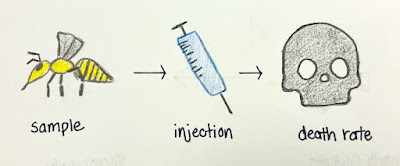By Kaylen Maat, Bridget Walicki, and Molly Witkop
 |
| [1] |
In today's day and age, the world is filled with an alarming amount of pollutants. While most people are aware of major issues such as global warming and climate change, some tend to forget about the ‘smaller’ problems such as microplastics. When you hear the words plastic pollution, you may think of turtles dying from plastic filling their guts; however, you may not think of these plastics harming little bees. Microplastics can be everywhere from beauty products to the innermost systems of honey bees. Microplastics, or plastic pollutants smaller than five millimeters, infiltrate our environment by breaking off of larger plastics. The overall high use of plastic has led to an abundance of these particles in the environment. Sea turtles and other aquatic life are not the only ones harmed by the amount of microplastics circulating. Recently, a study in China was released that showed the impact of these microplastics on honey bees and their overall health.
The article “Microscopic Polystyrene Ingestion Promotes the Susceptibility of Honeybee to Viral Infection” by Deng et. al., dives into the consequences of microplastics, and how exposure made honey bees more susceptible to viral infections. The researchers suggest that the bees might ingest microplastics by consuming nectar, pollen, or water that is contaminated, as well as through its adhesion to their body hairs. The scientists then studied the bees to see if and how the plastics move throughout their guts into their tissues. This is significant to study as it impacts overall honey bee health. Humans are inherently invested in honey bee health because they are vital pollinators that keep the ecosystem going and also help produce the products that humans profit from.
The researchers conducted their experiment through a study where they used two types of honey bees: Apis mellifera and Apis cerana. For each species, three colonies were randomly selected from the provinces of Beijing, Jilin, and Henan where the experiment was conducted. Researchers then collected 50 bees from the three colonies and tested for microplastics, where they found around 20 different types. After identifying the different types of microplastics using a search algorithm and database, the researchers chose Polystyrene, a common microplastic used in packaging materials and disposable products, as the focus of their study.
 |
| [5] |
Deng, Yanchun; Jiang, Xuejian; Zhao, Hongxia, et al. “Microplastic Polystyrene Ingestion Promotes the Susceptibility of Honeybee to Viral Infection.” Environmental Science & Technology, vol. 55, no. 17, Sept. 2021, pp. 11680–92. DOI.org (Crossref), https://doi.org/10.1021/acs.est.1c01619.
Chen, Yan Ping; Pettis, Jeffery S.; Corona, Miguel, et al. “Israeli Acute Paralysis Virus: Epidemiology, Pathogenesis and Implications for Honey Bee Health.” PLOS Pathogens, vol. 10, no. 7, July 2014, p. e1004261. PLoS Journals, https://doi.org/10.1371/journal.ppat.1004261.
Photo taken by Bridget Walicki
Photo of drawing by Bridget Walicki
Photo of drawing by Molly Witkop
Photo of drawing by Molly Witkop
Photo of drawing by Bridget Walicki




